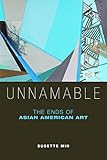Unnamable : The Ends of Asian American Art / Susette Min.
Material type: TextPublisher: New York, NY : New York University Press, [2018]Copyright date: ©2018Description: 1 online resource : 65 black and white illustrationsContent type:
TextPublisher: New York, NY : New York University Press, [2018]Copyright date: ©2018Description: 1 online resource : 65 black and white illustrationsContent type: - 9780814764299
- 9780814764312
- 704.03/95073 23
- online - DeGruyter
| Item type | Current library | Call number | URL | Status | Notes | Barcode | |
|---|---|---|---|---|---|---|---|
 eBook
eBook
|
Biblioteca "Angelicum" Pont. Univ. S.Tommaso d'Aquino Nuvola online | online - DeGruyter (Browse shelf(Opens below)) | Online access | Not for loan (Accesso limitato) | Accesso per gli utenti autorizzati / Access for authorized users | (dgr)9780814764312 |
Browsing Biblioteca "Angelicum" Pont. Univ. S.Tommaso d'Aquino shelves, Shelving location: Nuvola online Close shelf browser (Hides shelf browser)

|

|

|

|

|

|

|
||
| online - DeGruyter Original Sin : Clarence Thomas and the Failure of the Constitutional Conservatives / | online - DeGruyter Post-Bellum, Pre-Harlem : African American Literature and Culture, 1877-1919 / | online - DeGruyter Moral and Political Education : NOMOS XLIII / | online - DeGruyter Unnamable : The Ends of Asian American Art / | online - DeGruyter Masculinity at Work : Employment Discrimination through a Different Lens / | online - DeGruyter Prosecution Complex : America's Race to Convict and Its Impact on the Innocent / | online - DeGruyter Pranksters : Making Mischief in the Modern World / |
restricted access online access with authorization star
http://purl.org/coar/access_right/c_16ec
Redraws the contours of Asian American art, attempting to free it from a categorization that stifles more than it reveals. Charting its historical conditions and the expansive contexts of its emergence, Susette Min challenges the notion of Asian American art as a site of reconciliation or as a way for marginalized artists to enter into the canon or mainstream art scene. Pressing critically on the politics of visibility and how this categorization reduces artworks by Asian American artists within narrow parameters of interpretation, Unnamable reconceives Asian American art not as a subset of objects, but as a medium that disrupts representations and embedded knowledge. By approaching Asian American art in this way, Min refigures the way we see Asian American art as an oppositional practice, less in terms of its aspirations to be seen-its greater visibility-and more in terms of how it models a different way of seeing and encountering the world. Uniquely presented, the chapters are organized thematically as mini-exhibitions, and offer readings of select works by contemporary artists including Tehching Hsieh, Byron Kim, Simon Leung, Mary Lum, and Nikki S. Lee. Min displays a curatorial practice and reading method that conceives of these works not as "exemplary" instances of Asian American art, but as engaged in an aesthetic practice that is open-ended. Ultimately, Unnamable insists that in order to reassess Asian American art and its place in art history, we need to let go not only of established viewing practices, but potentially even the category of Asian American art itself.Redraws the contours of Asian American art, attempting to free it from a categorization that stifles more than it reveals. Charting its historical conditions and the expansive contexts of its emergence, Susette Min challenges the notion of Asian American art as a site of reconciliation or as a way for marginalized artists to enter into the canon or mainstream art scene. Pressing critically on the politics of visibility and how this categorization reduces artworks by Asian American artists within narrow parameters of interpretation, Unnamable reconceives Asian American art not as a subset of objects, but as a medium that disrupts representations and embedded knowledge. By approaching Asian American art in this way, Min refigures the way we see Asian American art as an oppositional practice, less in terms of its aspirations to be seen-its greater visibility-and more in terms of how it models a different way of seeing and encountering the world. Uniquely presented, the chapters are organized thematically as mini-exhibitions, and offer readings of select works by contemporary artists including Tehching Hsieh, Byron Kim, Simon Leung, Mary Lum, and Nikki S. Lee. Min displays a curatorial practice and reading method that conceives of these works not as "exemplary" instances of Asian American art, but as engaged in an aesthetic practice that is open-ended. Ultimately, Unnamable insists that in order to reassess Asian American art and its place in art history, we need to let go not only of established viewing practices, but potentially even the category of Asian American art itself.
Mode of access: Internet via World Wide Web.
In English.
Description based on online resource; title from PDF title page (publisher's Web site, viewed 01. Nov 2023)


